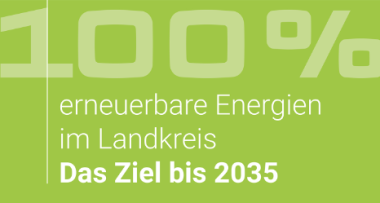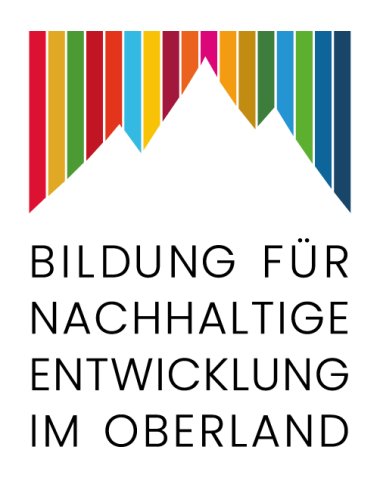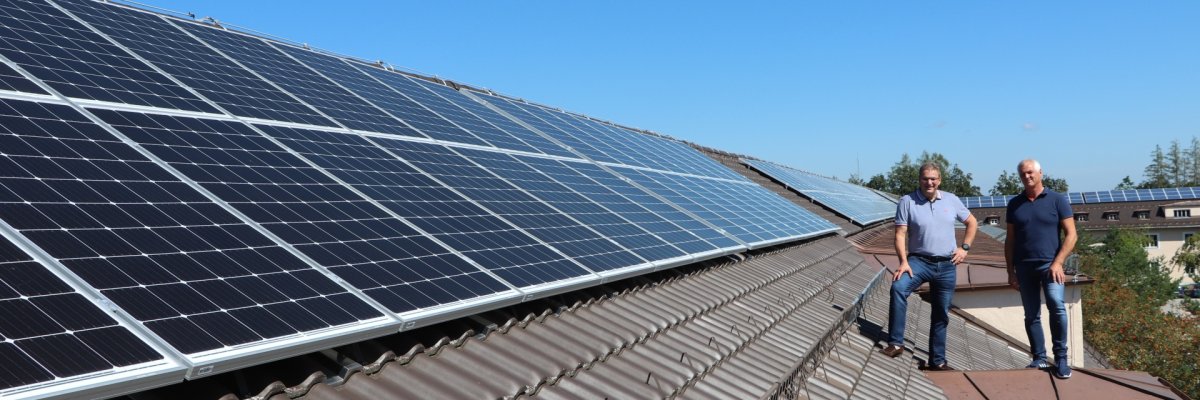Climate protection
The district has signed up to the Oberland energy transition target of covering 100% of its energy requirements from renewable energies by 2035.

The district's climate protection work is based on its own integrated climate protection concept, which the climate protection management team has been tasked with implementing. In addition, the Energy Advisory Board was set up to advise the Committee for the Environment, Infrastructure and Tourism on energy issues.
Tasks of the climate protection officer:
- Implementation of the district's climate protection concept
- Provision of energy advice and information on subsidies
- Updating the everyday cycle path concept, signage and infrastructure
- Contact point for the Education for Sustainable Development network in the Oberland (ESD)
Energy Advisory Board
The district wants to act as a role model and central driving force for the development and implementation of climate protection measures in the region.
To advise the district council, the committees and the district administrator on issues relating to the implementation of the climate protection concept, an interdisciplinary and non-partisan body - the Energy Advisory Board - was therefore set up.
The action plan drawn up by the expert committee for the implementation of the climate protection concept prioritizes the fields of action from the climate protection concept according to feasibility and importance. This action plan was unanimously adopted by the Environment and Infrastructure Committee and represents the current working basis for the district's climate protection activities. The members of the advisory board can be viewed in the citizen information system.
Integrated climate protection concept
By drawing up a climate protection concept, the district of Bad Tölz-Wolfratshausen aims to improve its climate protection policy activities together with its municipalities and thus fulfill its role as a role model and central driving force for the development and implementation of climate protection measures in the region. The overall aim of the integrated climate protection concept is to reduce energy consumption and CO2 emissions in the district.
In the period from 01.10.2012 to 30.09.2013, B.A.U.M. Consult GmbH from Munich drew up a "Climate protection concept for the district of Bad Tölz-Wolfratshausen and its municipalities". By drawing up a climate protection concept, the district of Bad Tölz-Wolfratshausen aims to improve its climate protection policy activities together with its municipalities and thus fulfill its role as a role model and central driving force for the development and implementation of climate protection measures in the region. The overall aim of the integrated climate protection concept is to reduce energy consumption and CO2 emissions in the district. In addition, the district's energy supply is to be converted to renewable energy sources by 2035 in accordance with the district council resolution. To this end, further potential for action is to be tapped in addition to the measures already taken. The concept should also provide information on the regional potential for value creation when switching to renewable energy sources and contain a detailed, realistic catalog of measures for implementation. The climate protection concept and the associated action plan form the working basis for the position of climate protection manager.
Areas of action
Heat transition
When switching from fossil fuels to renewable energies, it is particularly important to rethink heat generation. The district offers various forms of assistance to support citizens in replacing their heating systems and to provide information on the various heating technologies.
Renewable energies: Focus on solar energy
A look at the solar atlas clearly shows that our region is excellently suited for solar energy generation. To check how suitable your own roof is for a solar system, the district offers a solar potential register.
Making mobility more environmentally conscious
Around 40% of CO2 emissions in the district are caused by the transport sector. In order to achieve our climate targets, it is therefore essential to make our mobility more environmentally friendly. A major lever here is the promotion of bicycle mobility. For this reason, the district has a cycling concept with a focus on everyday cycling, which is continuously updated. To increase mobility awareness, the district also takes part in the city cycling campaign every year
Updating the energy & CO2 balance
An important basis for climate protection work is a meaningful database that can be used to measure progress.
For this reason, the district has been drawing up a carbon footprint every two years since 2017. The balance is drawn up in accordance with the BISKO standard with the help of the climate protection planner. You can download the entire balance sheet as a PDF or view a brief overview via Infogram.
Climate protection in municipalities
Climate protection is a task for society as a whole, which must also be tackled by all public bodies. In order to support smaller municipalities in particular, the district is working closely with its local authorities.
Actions of the municipalities: Benediktbeuern, Bichl, Dietramszell, Egling, Eurasburg, Gaißach, Geretsried, Greiling, Icking, Jachenau, Kochel am See, Königsdorf, Lenggries, Münsing, Reichersbeuern, Sachsenkam, Schlehdorf, Wackersberg, Wolfratshausen
Campaigns
In addition to the essential measures to reduce emissions, public relations work to raise awareness in society is also important. To this end, the district participates in campaigns such as the Oberland Climate Spring and city cycling.
Climate Spring Oberland
 District of Bad Tölz-Wolfratshausen
District of Bad Tölz-WolfratshausenIn spring 2018, the "Climate Spring Oberland" took place for the first time in the districts of Garmisch-Partenkirchen and Bad Tölz-Wolfratshausen. From 2022, the Klimafrühling Oberland will also be co-organized by the district of Miesbach, the towns of Penzberg and Weilheim and the Bürgerstiftung Energiewende Oberland. The Oberland Climate Spring is an event platform for all educational institutions, initiatives, associations, foundations, religious institutions and companies and takes place over a period of almost 3 weeks. The aim of the Oberland Climate Spring is to make the commitment to climate protection visible with a wide variety of events. The event format is aimed at all citizens of the region in order to inform and activate them for the topic of "climate change and climate protection" and to awaken their desire for joint commitment. In 2024, the program included more than 160 individual events at over 30 locations throughout the Oberland, attracting a total of around 10,000 interested people from the entire region. Do you have an event idea and want to be part of the next Climate Spring? Then send an email to klimaschutz@lra-toelz.de.
Further information and impressions of the last Climate Spring can be found on the Climate Spring homepage.
City cycling
Sustainable mobility is an important aspect of climate protection.
 Climate Alliance Services
Climate Alliance ServicesIn addition to the promotion of alternative drive systems and public transport, the strengthening of everyday cycling also plays a major role here. To promote mobility awareness, the district of Bad Tölz-Wolfratshausen has been taking part in the CITY CYCLING campaign organized by the Climate Alliance since 2018. STADTRADELN is a competition in which the aim is to cycle as many everyday journeys as possible in a climate-friendly way for 21 days. It doesn't matter whether you already cycle every day or have rarely cycled so far. Every kilometer counts - especially if you would otherwise have covered it by car. City cycling takes place throughout the Oberland every year between May and June and runs for 21 days. The campaign period is accompanied by an attractive supporting program on the subject of cycling. Every year, the district-wide evaluation gives particularly hard-working teams the chance to win a small prize, which is presented at the award ceremony at the district administration office.
You can find all information about city cycling at the following link.
Education
It is not only important to take action now, but also to prepare future generations for the challenges associated with global warming.
The key to this is education for sustainable development (ESD), which empowers people to act in a sustainable way. By promoting educational projects and connecting educational stakeholders via a network, the district is committed to strengthening climate protection education.
Education for sustainable development
 Ecological Academy e.V.
Ecological Academy e.V.The topic of education is also an important measure in the action plan for the integrated climate protection concept. However, it is not only education in the area of climate protection that needs to be strengthened. It is now clear that we need to think more broadly here. The keyword here is "education for sustainable development", or ESD for short. This refers to education that enables people to think and act in a sustainable way. It enables each individual to understand the impact of their own actions on the world. The focus here is on various questions. For example: How do my decisions affect people of future generations in my community or in other parts of the world? What impact does it have, for example, how I consume, which means of transportation I use or which and how much energy I consume? What global mechanisms lead to conflicts, terror and displacement? Or what can we do to combat poverty?
 UN Information Service (UNIS) Vienna.17 Sustainable development goals
UN Information Service (UNIS) Vienna.17 Sustainable development goalsWith the vision of creating a peaceful and sustainable society, the United Nations adopted the global sustainability agenda in the fall of 2015. 17 goals form the core of the agenda and also summarize the topics that ESD deals with.
The district's climate protection management has been promoting educational projects in the field of climate and environmental protection for several years now. In 2022, the climate protection management team founded the "Education for Sustainable Development Oberland" network together with the Ökologische Akademie e.V. The network aims to connect all active ESD education stakeholders in the region so that they can exchange ideas, work together and benefit from synergy effects. The aim is to better coordinate offers, plan joint activities, promote the creation of new learning locations and create an even broader educational offer for the region in the long term. You can find more information about the network and the ESD offers in the region on the homepage.

"Funded by the Federal Ministry for the Environment, Nature Conservation and Nuclear Safety on the basis of a resolution of the German Bundestag".
The project on which this report is based was funded by the Federal Ministry of Education and Research under grant number 03KS3188. The author is responsible for the content of this publication (document is not barrier-free).
